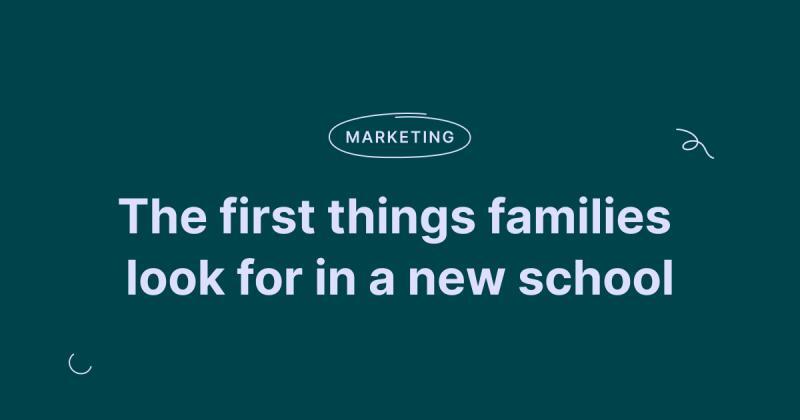Education marketers have a massive advantage when it comes to the enrollment communications flow. Here I want to show you how to leverage this unique opportunity.
Every independent school, college, and university has an enrollment communications flow. It’s simply the nature of the enrollment process to have a consistent back-and-forth between you and the prospective student.
For most schools, the enrollment communications flow becomes a routine administrative habit.
Requests for information, applications, deposits, acceptance letters – it’s all part of the template communications you have stored in a hard drive or file folder.
But if you only use template messages in your “comm flow,” you might never see the full potential of this marketing opportunity.
If you think about it, your enrollment communications flow is another channel you can use to send marketing messages. It’s a way to develop your education brand and build loyalty.
And not only can you achieve your marketing goals using your school’s comm flow, you can also help motivate prospective students to move on to the next step in the comm flow process.
Maximize Your Requests for Information
The student request for information form is typically the beginning of the enrollment communications flow. Many independent schools, colleges, and universities now have their requests for information online.
In a previous communications flow blog, I highly recommended rewarding your prospective students with a piece of gated content just for filling out the form.
You’ve probably offered some kind of content in exchange for a student’s email address.
This “ethical bribe” approach is now a very common strategy for lead capturing.
It may not have occurred to you, but your online request for information form is nothing more than a beefed up lead capture form.
Why not give your prospective students something of value in exchange for their permission to send them information about your school?
Since they’re giving you a good amount of information about themselves, I suggest creating a substantial content piece – one that will serve them well whether they enroll at your school or not. Something like a…
- Guide to picking the right college
- Manual for finding and applying for financial aid
- Checklist of questions to ask during a college visit
- Primer on how to choose a major/career
Your prospective student has a lot of questions for you.
By offering to answer some of their most pressing questions in a piece of content at the end of the request for information, you can motivate them to finish the form and kickstart the enrollment communications flow.
If you’re wondering if all this work is worth it for your request for information forms, remember that those who “raise their hand” to get more information are the most valuable leads. Often, they’re much more valuable than purchased names from College Board or other reputable brokers.
Leverage Your Application Forms
Filling out applications can be a lengthy, boring task.
When your prospective students send in or submit their application online, this is an opportune moment to launch a messaging campaign. You can do this via email, print, social media – or even better – all of the above.
Of course, the very first message to get across to your prospective student is “Thank you!” Filling out the admissions form is a tremendous step forward in their enrollment journey.
Secondly, you want to reinforce the idea that they made the right choice.
You can do this by sending student video testimonials or online written testimonials. Another way is to send them info on the advantages current students enjoy on your campus and in the classroom.
In this series of messaging, be sure to send invitations to your campus-days events.
While no one can make filling out admissions forms an exciting task, using it as a trigger for a series of marketing campaigns is a way to keep the momentum high in the enrollment communications process.
And keep in mind, it doesn’t have to happen AFTER they submit the application. It should start when they START the application. Too many applications are “empty shopping carts” left uncompleted.
Amp Up Your Acceptance Letters
Unlike application forms, receiving acceptance letters is an exciting experience for your prospective student.
In fact, there’s a growing trend of young students posting their reactions to acceptance letters to YouTube.
This YouTube compilation of college acceptance reactions got over 187,000 views!
What does this cultural phenomenon mean for education marketers?
Enrollment communications flow pieces like acceptance letters can now be an incredible opportunity to put your brand front and center of the excitement.
For each of these young people, their entire community of friends, family, and followers can see their visceral reaction to each college acceptance letter.
Imagine your college or university logo in their YouTube video. In today’s 24/7 connected world, it’s not far-fetched to think that your college might be featured in a future YouTube video.
Demand for video content has been growing steadily over the years, but Gen Z students are going well beyond what previous generations ever did.
Many of them document even the most mundane aspects of their young lives for the world to see – and it doesn’t appear to be letting up.
So how do you leverage this free exposure?
If you’re sending an email acceptance letter, be sure that your logo appears clearly at the top. If you can, include a welcome video (especially if it features current students) welcoming the prospective student somewhere in the email.
Another idea is to include a custom GIF image welcoming the prospective student. Be sure to include visual brand elements in the GIF like your mascot, campus landmarks, or other noteworthy parts of your school identity.
Finally, include a hashtag in your letter to lead your prospective student and anyone who sees your acceptance letter in a shared video or photo to the larger conversation about your brand.
Feature Financial Aid
Probably the scariest part of the college decision process, especially for parents, is how to pay for it. It’s a common scenario for students and parents to agonize over the expenses of their college education.
This is where your financial aid communications can really shine a welcome light on a difficult subject.
Too often, schools will bury their financial aid resources in their website menus, and when the prospective student clicks on it, they land on a page with dense legal and financial language.
It’s like reading something written by a lawyer or bureaucrat.
Don’t let this happen to your financial aid communications!
Show how your school really cares by writing in an encouraging and simple way about money. Assure them that this investment is worth it, and that there is help for them at every turn.
Explain the forms patiently and in detail. Part of the anxiety they have is not knowing how things work. You can help take away that anxiety through clear, helpful financial aid communications.
Storytelling is a powerful technique you can use in financial aid content.
Probably the easiest way to take away anxiety over costs and explain the details of financial aid is to tell the story of other students who’ve gone through the financial aid process with your team.
As prospective students and their families see how you’ve walked with other students through the financial aid process, they’ll feel more confident that you’ll take care of them too.
Also, I recommend telling the financial story in terms of how students understand: cost per semester or year…not in cost per credit hour.
Cost per credit hour is the WORST way to present the information.
Students do not speak that language. Present your info in the “typical” scenario of a full-time equivalent student.
Throughout your financial aid communications, take every opportunity you can to reinforce your marketing messaging to show them how your organization’s values shape how you’re guiding them through the financial aid process.
This is another opportune place to offer gated content such as education cost calendars, financial aid explainer videos, or white papers you create about the financial aid process.
So there you have it – 4 Ways to Leverage Your Enrollment Communications Flow.
Click here to read this article on the Caylor Solutions website.

![[PODCAST] Why Doesn’t Your School Have a Retention Strategy with Mike Ziemski](https://www.schoolhouse.agency/wp-content/uploads/2021/08/PODCAST-Why-Doesnt-Your-School-Have-a-Retention-Strategy-with-Mike-Ziemski.png)



